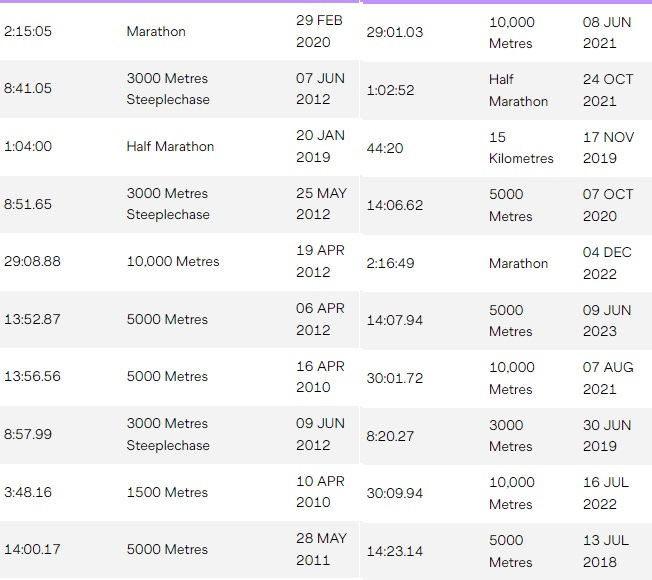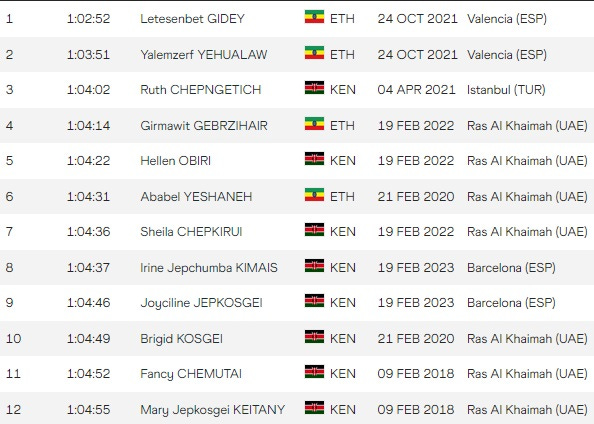The best female distance runners alive would win most U.S. ultramarathons outright
It's too bad the incentives aren't there
Below are the top ten track and road marks of two well-known active distance runners, ordered by World Athletics points.
The WA point system is a little shaky; you won’t convince me, for example, that a 1:02:52 half-marathon is inferior to a 29:01 track 10K. But that quibbling aside, we* can surely agree that these two runners are similar in ability. If they were both American men, we would classify them as almost-national-class.
The column on the left is in fact from the résumé of an American male, Jim Walmsley. The other comes from the World Athletics profile page for Letesenbet Gidey, the 25-year-old Ethiopian who holds the women’s world records in the 10,000-meter run (29:01) and the half-marathon (1:02:52). Gidey recently lost the 5,000-meter world record (that 14:06.62 from 2020) to Kenya’s Faith Kipyegon in a race in Paris in which Kipyegon defeated her.
Walmsley is widely regarded as one of the best American ultramarathon runners ever to infiltrate the discipline. In 2018, he broke the course record at the Western States Endurance Run—a 100-mile race widely regarded as the most prestigious ultramarathon in the United States; the next year, widely regarded to be 2019, he broke his own still-shimmering record by over 20 minutes.
There is no reason to believe that Gidey couldn’t be as successful in men’s ultramarathon running as Walmsley has been if she had the right financial incentives to compete in those races and spent maybe six months specifically preparing herself for the rigors of an ultramarathon lasting more than half a day in a best-case scenario.
Gidey’s half-marathon record is freakishly fast, but the sport is rapidly accumulating East African women clearly as talented as Walmsley and other highly regarded male American ultramarathoners.
The all-time women’s half-marathon list:
I’m making this post because the 2023 WSER concluded yesterday, with cool conditions—and who the heck knows what the fuck else—allowing Courtney Dauwalter to shatter the women’s course record by about 78 minutes, or 47 seconds per mile. Dauwalter was only 49 minutes behind the male winner, Tom Evans of Great Britain, despite Evans himself running the fourth-fastest time in the event’s history. That’s a difference of only 5.6 percent, about half the difference between the top men and women in road and track events and close to three times the typical difference at the high-school and U.S. collegiate levels.
Given the vagaries involved in very long footraces and the difference in talent between the top levels of track and road running and the top levels of ultramarathon running, I would propose that if Ethiopia, Kenya, and Japan could each enter their ten best women runners in the men’s division of any ultramarathon in the United States, there is at least a 50 percent chance one of those women would win the event, and a greater than 50 percent chance of this happening were men’s field were limited to U.S.-born Americans.
We* will never find out whether this is true, not because of issues with Bayesian statistics but because the best women in the world don’t compete in ultramarathons. They have no incentive whatsoever to do so, because the sport has developed in a way that treats races between ten seconds and two and one-half hours as the most valuable to excel at and thus the most marketable to sponsors and the rest of the world.
At the same time, does anyone have any cogent arguments about why a bunch of properly trained 19- to 29-year-old East African (or East Asian) women on EPO could not keep up with Jim Walmsley or rising U.S. star Adam Peterman, whose fastest 5,000 meters (14:08, run indoors) is slower than Gidey’s? I don’t know what those would even look like.
Speaking of EPO, this post could have gone in a “Dauwalter is cheating” direction, but that part is, in my mind, a given. One of the reasons I avoid following ultras closely, especially the WSER, is that some of the most obnoxious public figures in the sport, are either setting records themselves (e.g., supreme egoist and waffling waterhead Camille Herron) or enamored of the shitbags who excel in these events. Dean Karnazes is one of the most dishonest and obnoxious dingbats in the annals of organized perambulation, and his bullshit-saturated magnum opus, now almost 20 years old, centers on his WSER participation. Over the years, ultras have also attracted half-literate, bullshitting goobers like Dane Rauschenberg and many, many other frauds, fakers, and fuckups.
Currently, the biggest advocates and followers of ultramarathons in the remnants of the corporate running media and on Twitter are blithering self-promoters with room-temperature IQs and enough unearned cash to move to a home within ten miles of my own, where they embark on endless microphallic- or vulvospastic-based capering and yabbering. I have long gotten most of my information about races 26.23 miles long or longer from one site, and Ultrarunner Podcast site isn’t as active as it once was, perhaps because its founder is growing weary of the endless kind of nonsense ultramarathoners and trail runners specifically import to the running milieu, perhaps not. But other options include Trail Runner, where David Roche published a WSER ‘23 prediction that was apparently as dismal as predictions get (and one of his closeted hecklers is reportedly working on a sarcaustic response to that prediction, which I will publish whenever it is supplied).



